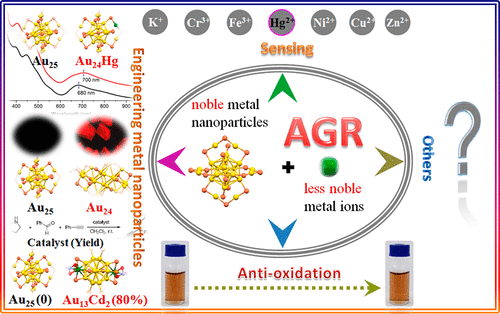当前位置:
X-MOL 学术
›
Acc. Chem. Res.
›
论文详情
Our official English website, www.x-mol.net, welcomes your
feedback! (Note: you will need to create a separate account there.)
Discovery, Mechanism, and Application of Antigalvanic Reaction
Accounts of Chemical Research ( IF 16.4 ) Pub Date : 2018-10-31 00:00:00 , DOI: 10.1021/acs.accounts.8b00374 Zibao Gan 1, 2 , Nan Xia 1, 2 , Zhikun Wu 1, 2
Accounts of Chemical Research ( IF 16.4 ) Pub Date : 2018-10-31 00:00:00 , DOI: 10.1021/acs.accounts.8b00374 Zibao Gan 1, 2 , Nan Xia 1, 2 , Zhikun Wu 1, 2
Affiliation

|
Among many outstanding findings associated with the quantum size effect, one of the most exciting is the discovery of the antigalvanic reaction (AGR), which is the opposite of the classic galvanic reaction (GR) that has a history of nearly 240 years. The GR, named after Italian scientist Luigi Galvani, involves the spontaneous reduction of a noble-metal cation by a less noble metal in solution driven by the difference in electrochemical potentials. Classic galvanic reduction has been widely applied and has recently received particular interest in nanoscience and nanotechnology. However, the opposite of GR, that is, reduction of metal ions by less reactive (or more noble) metals, has long been regarded as a virtual impossibility until the recent surprising findings regarding atomically precise ultrasmall metal nanoparticles (nanoclusters), which bridge the gap between metal atoms (complexes) and metal nanocrystals and provide opportunities for novel scientific findings due to their well-defined compositions and structures. The AGR is significant not only because it is the opposite of the classic galvanic theory but also because it opens extensive applications in a large range of fields, such as sensing and tuning the compositions, structures, and properties of nanostructures that are otherwise difficult to obtain. Starting with the proposal of the general AGR concept in 2012 by Wu, a new era began, in which AGR received widespread attention and was extensively studied. After years of effort, great advances have been achieved in the research on AGR, which will be reviewed below.
中文翻译:

抗电流反应的发现,机理及应用
在与量子尺寸效应相关的许多杰出发现中,最令人兴奋的发现之一就是抗电流反应(AGR)的发现,这与已有近240年历史的经典电流反应(GR)相反。以意大利科学家路易吉·加尔瓦尼(Luigi Galvani)的名字命名的GR涉及一种由电化学势差驱动的溶液中的一种稀有金属自发还原一种贵金属阳离子的方法。经典的电流减少已被广泛应用,并且最近在纳米科学和纳米技术中引起了特别的兴趣。然而,GR的反面,即反应性较低(或更贵重的金属)还原金属离子一直被认为是不可能的,直到最近关于原子精确的超小型金属纳米颗粒(纳米团簇)的令人惊讶的发现,由于其定义明确的组成和结构,它们弥合了金属原子(络合物)和金属纳米晶体之间的间隙,并为新颖的科学发现提供了机会。AGR的意义重大,不仅因为它与经典的流电理论相反,而且还因为它在广泛的领域中打开了广泛的应用领域,例如感测和调整否则很难获得的纳米结构的组成,结构和性质。从Wu在2012年提出一般AGR概念开始,新时代开始了,AGR受到了广泛的关注并得到了广泛的研究。经过多年的努力,AGR的研究取得了很大的进步,下面将进行综述。
更新日期:2018-10-31
中文翻译:

抗电流反应的发现,机理及应用
在与量子尺寸效应相关的许多杰出发现中,最令人兴奋的发现之一就是抗电流反应(AGR)的发现,这与已有近240年历史的经典电流反应(GR)相反。以意大利科学家路易吉·加尔瓦尼(Luigi Galvani)的名字命名的GR涉及一种由电化学势差驱动的溶液中的一种稀有金属自发还原一种贵金属阳离子的方法。经典的电流减少已被广泛应用,并且最近在纳米科学和纳米技术中引起了特别的兴趣。然而,GR的反面,即反应性较低(或更贵重的金属)还原金属离子一直被认为是不可能的,直到最近关于原子精确的超小型金属纳米颗粒(纳米团簇)的令人惊讶的发现,由于其定义明确的组成和结构,它们弥合了金属原子(络合物)和金属纳米晶体之间的间隙,并为新颖的科学发现提供了机会。AGR的意义重大,不仅因为它与经典的流电理论相反,而且还因为它在广泛的领域中打开了广泛的应用领域,例如感测和调整否则很难获得的纳米结构的组成,结构和性质。从Wu在2012年提出一般AGR概念开始,新时代开始了,AGR受到了广泛的关注并得到了广泛的研究。经过多年的努力,AGR的研究取得了很大的进步,下面将进行综述。











































 京公网安备 11010802027423号
京公网安备 11010802027423号